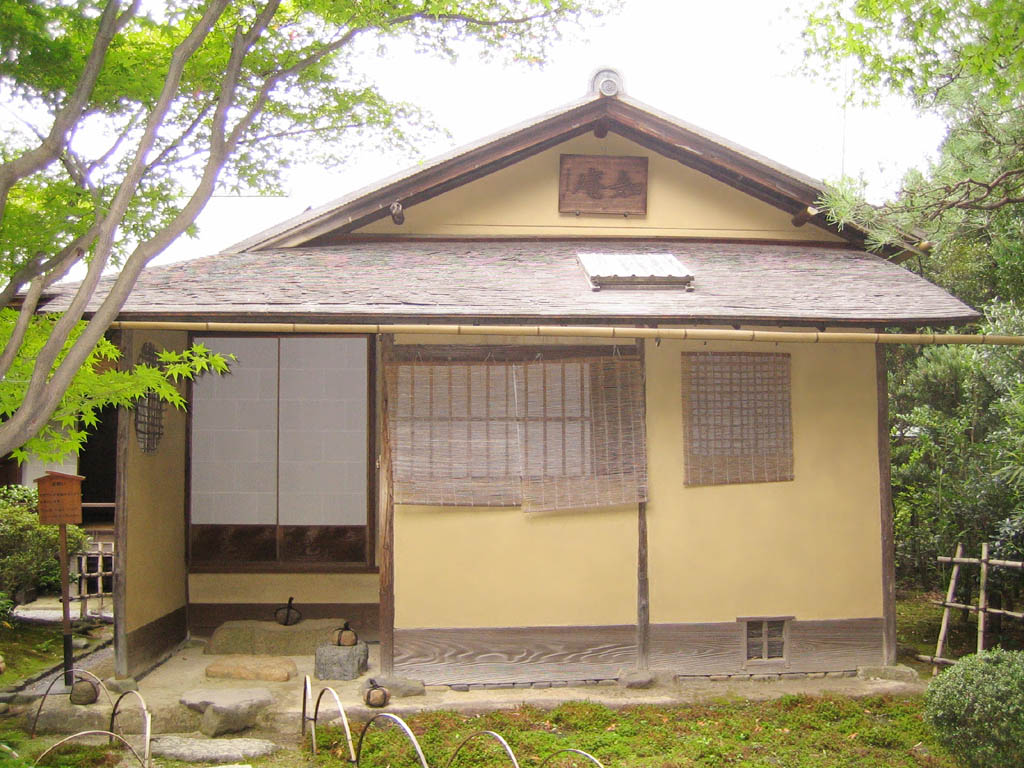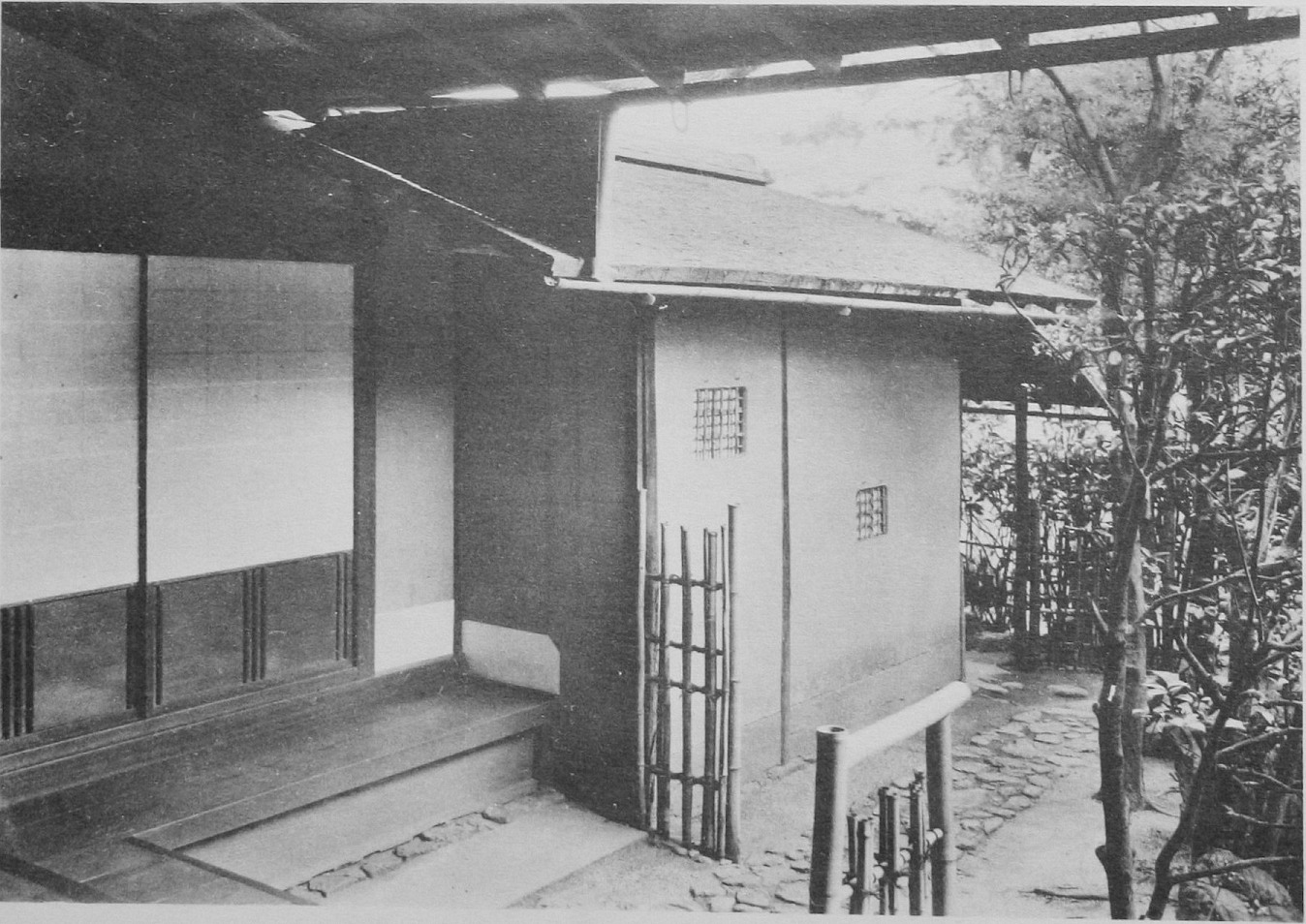|
Wabi-cha
''Wabi-cha'' (; ; ), is a style of Japanese tea ceremony particularly associated with Sen no Rikyū, Takeno Jōō and its originator Murata Jukō. ''Wabi-cha'' emphasizes simplicity. The term came into use in the Edo period, prior to which it was known as ''wabi-suki'' (), ''suki'' meaning "artistic inclination", and "''wabi''" meaning 'forlorn'. History By the latter years of the Muromachi period, tea ceremony had become widespread, with a preference for expensive wares of Chinese origin known as ''karamono''. ''Wabi-cha'' evolved as part of a movement to appreciate local wares and simpler styles. Generally, three main figures are credited with the development of the wabi-cha aesthetic form of chanoyu: first, Murata Jukō; then, Takeno Jōō; and finally, Sen no Rikyū. Rikyū cited two poems from the ''Shin Kokin Wakashū'' poetry anthology of the early thirteenth century, as exemplifying his ''wabi'' aesthetic. One, a favorite of Takeno Jōō's, is by Fujiwara no Teika (116 ... [...More Info...] [...Related Items...] OR: [Wikipedia] [Google] [Baidu] |
Chashitsu
''Chashitsu'' (, "tea room") in Japanese tradition is an architectural space designed to be used for tea ceremony (''chanoyu'') gatherings. The architectural style that developed for ''chashitsu'' is referred to as the ''sukiya'' style (''sukiya-zukuri''), and the term ''sukiya'' () may be used as a synonym for ''chashitsu''. Related Japanese terms are ''chaseki'' (), broadly meaning "place for tea", and implying any sort of space where people are seated to participate in tea ceremony, and ''chabana ''Chabana'' (茶花, literally "tea flowers") is a generic term for the arrangement of flowers put together for display at a Japanese tea ceremony, and also for the wide variety of plants conventionally considered as appropriate material for ...'', "tea flowers", the style of flower arrangement associated with the tea ceremony. Typical features of ''chashitsu'' are ''shōji'' windows and sliding doors made of wooden lattice covered in a translucent washi, Japanese paper; ' ... [...More Info...] [...Related Items...] OR: [Wikipedia] [Google] [Baidu] |
Sen No Rikyū
, also known simply as Rikyū, is considered the historical figure with the most profound influence on ''chanoyu,'' the Japanese "Way of Tea", particularly the tradition of '' wabi-cha''. He was also the first to emphasize several key aspects of the ceremony, including rustic simplicity, directness of approach and honesty of self. Originating from the Sengoku period and the Azuchi–Momoyama period, these aspects of the tea ceremony persist. Rikyū is known by many names; for consistency, he will be referred to as Rikyū in this article. There are three ''iemoto'' (''sōke''), or 'head houses' of the Japanese Way of Tea, that are directly descended from Rikyū: the Omotesenke, Urasenke, and Mushakōjisenke, all three of which are dedicated to passing forward the teachings of their mutual family founder, Rikyū. Early life Rikyū was born in Sakai in present-day Osaka Prefecture. His father was a warehouse owner named , who later in life also used the family name Sen, and his ... [...More Info...] [...Related Items...] OR: [Wikipedia] [Google] [Baidu] |
Takeno Jōō
was a master of the tea ceremony and a well-known merchant during the Sengoku period of the 16th century in Japan. His name has come down in Japanese cultural history because he followed Murata Jukō as an early proponent of wabi-cha, and was chanoyu teacher to Sen no Rikyū. It is believed that the family descended from the Takeda clan who were guardians of Wakasa Province. His father, Nobuhisa, changed the family name to Takeno, and after roaming the country, settled in Sakai, where he built up a thriving business dealing in leather goods used by warriors. Nobuhisa married the daughter of a priest of Kōfukuji temple in Yamato Province (present-day Nara Prefecture), Jōō's mother. While carrying on the family business in Sakai, Jōō, whose common name was Shingorō (新五郎), did religious duty as an attendant at the Hongan-ji temple in the Yamashina, Yamashiro Province (nowadays Kyoto). In 1532, he took the tonsure and came to be known as Jōō. Evidence shows tha ... [...More Info...] [...Related Items...] OR: [Wikipedia] [Google] [Baidu] |
Murata Jukō
is known in Japanese cultural history as the founder of the Japanese tea ceremony, in that he was the early developer of the wabi-cha style of tea enjoyment employing native Japanese implements. His name may also be pronounced Murata Shukō. Biography He was born in Nara; some accounts refer to his father as a blind '' biwa'' player, although it is generally assumed that he was from the mercantile class. At an early age, he became an attendant at Shōmyōji, a Buddhist temple of the Jōdō sect in Nara. During his youth, Jukō encountered the boisterous ''tocha'' gatherings of tea connoisseurs; although these held no appeal for him, he became interested in tea as a stimulant to keep him awake during his studies. His interest in tea took him to Kyoto, where he learned about the aristocratic practice of the tea ceremony from Nōami. It is recorded in the ''Record of Yamanoue Sōji'' that Jukō was employed by the shōgun Ashikaga Yoshimasa as a tea master at the Ginkaku-ji; how ... [...More Info...] [...Related Items...] OR: [Wikipedia] [Google] [Baidu] |
:Category:Japanese Words And Phrases ...
{{Commons Words and phrases by language Words Words Words A word is a basic element of language that carries an objective or practical meaning, can be used on its own, and is uninterruptible. Despite the fact that language speakers often have an intuitive grasp of what a word is, there is no consen ... [...More Info...] [...Related Items...] OR: [Wikipedia] [Google] [Baidu] |
Tea Room
A teahouse (mainly Asia) or tearoom (also tea room) is an establishment which primarily serves tea and other light refreshments. A tea room may be a room set aside in a hotel especially for serving afternoon tea, or may be an establishment which only serves cream teas. Although the function of a tearoom may vary according to the circumstance or country, teahouses often serve as centers of social interaction, like coffeehouses. Some cultures have a variety of distinct tea-centered establishments of different types, depending on the national tea culture. For example, the British or American tearoom serves afternoon tea with a variety of small snacks. Asia In China, Japan and Nepal, a teahouse (Chinese: , or , ; Japanese: ; Standard Nepali: ) is traditionally a place which offers tea to its customers. People gather at teahouses to chat, socialize and enjoy tea, and young people often meet at teahouses for dates. The Guangdong (Cantonese) style teahouse is particularly famous ... [...More Info...] [...Related Items...] OR: [Wikipedia] [Google] [Baidu] |
Chōjirō
(1516-?1592) is distinguished as the first generation in the Raku family line of potters. According to historical documents he was the son of one Ameya, who is said to have emigrated to Japan from Korea (or possibly Ming China, as asserted on the RAKU WARE website (link below) of the still active line of potters founded by Chojiro). Historical evidence shows that he produced ridge tiles for Toyotomi Hideyoshi's Jurakudai palace in 1574. There is a historical document reporting that in 1584, Toyotomi Hideyoshi presented him with a seal inscribed with the character 楽, ''raku'', and with this "Raku" was adopted as the family name. He worked at one time for Sen no Rikyū, the master of tea, at whose request he created teabowls to be used in chanoyu, the Japanese tea ceremony. Extant records of the use, at the time, of the tea bowls that he produced for Rikyū describe them as "tea bowls of the Sōeki form", Sōeki being the name that Rikyū was then generally known by.''Rikyū Daij ... [...More Info...] [...Related Items...] OR: [Wikipedia] [Google] [Baidu] |
Raku Ware
is a type of Japanese pottery traditionally used in Japanese tea ceremonies, most often in the form of ''chawan'' tea bowls. It is traditionally characterised by being hand-shaped rather than thrown, fairly porous vessels, which result from low firing temperatures, lead glazes and the removal of pieces from the kiln while still glowing hot. In the traditional Japanese process, the fired raku piece is removed from the hot kiln and is allowed to cool in the open air. The Western version of raku was developed in the 20th century by studio potters. Typically wares are fired at a high temperature, and after removing pieces from the kiln, the wares are placed in an open-air container filled with combustible material, which is not a traditional Raku practice in Japan. The Western process can give a great variety of colors and surface effects, making it very popular with studio and amateur potters. History In the 16th century, Sen no Rikyū, the Japanese tea master, was involved wit ... [...More Info...] [...Related Items...] OR: [Wikipedia] [Google] [Baidu] |
Sen Sōshitsu XV
is the 15th-generation Grand Master (''iemoto'') of Urasenke, which is one of the most widely known schools of Japanese tea, and served in official capacity from 1964 to 2002. In 1949, he received the Zen title Hōunsai (鵬雲斎). Following his retirement, he has adopted the name Sen Genshitsu (玄室), with the honorary title Daisosho, in order to distinguish him from his son and successor, Sen Sōshitsu XVI. For over seven decades, Dr. Sen Genshitsu has traveled across the world in order to promote the ethos of "Peacefulness through a Bowl of Tea". Early life Sen Genshitsu was born in Kyoto on 19 April 1923, the first son of the 14th-generation Urasenke iemoto (Sen Sōshitsu XIV, Mugensai Sekiso Sōshitsu (Tantansai), 1893-1964) and his wife, Kayoko (''née'' Ito Kayoko). Prior to his birth, Mugensai and Kayoko were already the parents of two daughters, Yaeko and Yoshiko. The birth of their first son, who would eventually become Mugensai's successor, occasioned much jubi ... [...More Info...] [...Related Items...] OR: [Wikipedia] [Google] [Baidu] |
Fujiwara No Teika
, better-known as Fujiwara no Teika"Sadaie" and "Teika" are both possible readings of ; "...there is the further problem, the rendition of the name in romanized form. Teika probably referred to himself as Sadaie, and his father probably called himself Toshinari, but the Sino-Japanese versions of their names were used by their contemporaries, and this practice is still observed." pg 681–692, note 2 of ''Seeds in the Heart: Japanese Literature from Earliest Times to the Late Sixteenth Century'', Donald Keene. 1999, Columbia University Press, (1162 – September 26, 1241), was a Japanese anthologist, calligrapher, literary critic,"The high quality of poetic theory (''karon'') in this age depends chiefly upon the poetic writings of Fujiwara Shunzei and his son Teika. The other theorists of ''tanka'' writing, stimulated by father and son either to agreement or disagreement, contributed also toward the high level of poetic theory, but we may say that Shunzei and Teika were most rep ... [...More Info...] [...Related Items...] OR: [Wikipedia] [Google] [Baidu] |
Fujiwara No Ietaka
was an early Kamakura period Japanese waka Waka may refer to: Culture and language * Waka (canoe), a Polynesian word for canoe; especially, canoes of the Māori of New Zealand ** Waka ama, a Polynesian outrigger canoe ** Waka hourua, a Polynesian ocean-going canoe ** Waka taua, a Māori w ... poet. Several of his poems are included in the '' Shin Kokin Wakashū''. He was related by marriage to Jakuren, which made him strongly connected to the network of poets of the time. He was a pupil to Fujiwara no Shunzei. Poetry Ietaka was involved in a number of poetic matches. One of these poems is from the : Ietaka also has a personal collection called the . References {{DEFAULTSORT:Fujiwara no, Ietaka Japanese poets 1158 births 1237 deaths Hyakunin Isshu poets ... [...More Info...] [...Related Items...] OR: [Wikipedia] [Google] [Baidu] |



